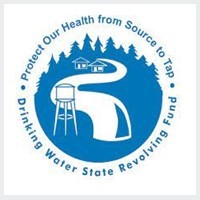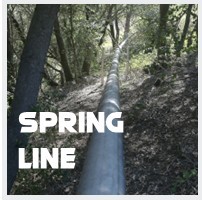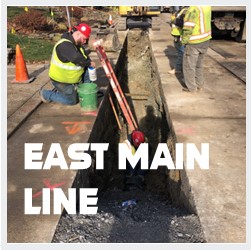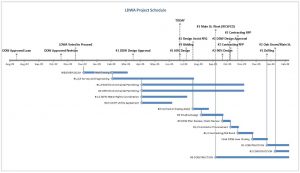Information Flow | LDWA System Project Update
Updated: 07/2023
The purpose of this page is to provide information about current Leeds Domestic Waterusers (LDWA) projects, and inform the community about potential impacts during construction. Although the LDWA understands that construction creates an inconvenience, it is committed to keeping the community informed.
Construction Project Updates
As a culinary water provider, we continuously upgrade, maintain, and repair our system so it can continue to serve our customers. The purpose of this page is to provide information about current LDWA projects, explain their need and benefits and inform the community about potential impacts during construction.
Although the LDWA understands that construction creates an inconvenience, it is committed to keeping the community informed of current projects, while working to minimize construction impacts as much as possible.
 Utah Division of Drinking Water, State Revolving Fund (SRF) Package
Utah Division of Drinking Water, State Revolving Fund (SRF) Package
On August 31, 2022, the Division of Drinking Water (DDW) Board met and authorized a loan of $7,519,500, with $3,499,500 principal forgiveness to LDWA for drilling a new well, installing a chlorinator, installing an altitude control valve and vault, replacing 4,500 feet of water main and transmission line replacement. The loan terms offered to the LDWA are forty (40) years, at an annual Interest Rate of 0%.
Current Project Schedule
 PROJECT 1 OVERVIEW :: New Well
PROJECT 1 OVERVIEW :: New Well
BACKGROUND :: LDWA currently gets its water from LDWA Spring and Highland Well. The water from the spring is shared with the Leeds Water Company (LWC) irrigation company. LDWA portion amounts averages about 120 gallons per minute. The well can produce approximately 335 gallons per minute. The total average source capacity adds up to 455 gallons per minute.
Over the years the several LDWA boards have wisely commissioned a number of Water Capacity Studies done, by multiple consulting engineers, on the system. In each of the last four studies (2007, 2015, 2017 & 2021), it was identified that the LDWA is deficient in source when using the State of Utah Drinking Water guidelines. It has been recommended that a new well location and well in the amount of 700 gallons per minute be secured, drilled, and developed.
In 2010 a Loan was entered into by the LDWA, and the projects scoped out within it was the drilling of a new well. Unfortunately, after 2 failed attempts to locate a suitable location, this project was terminated.
UPDATE :: This project has been divided into 2 parts: A) the well drilling/construction and B) the well house, new well equipping, chlorinator and altitude valve. Also, rather than drilling a pilot hole, it was suggested by our consulting professionals, that increasing the capacity of the existing well so as to determine the strength of the aquifer would be the best approach to locating the new well. This was done with great success and the new well has been located nearby, due to the unique capacity of the aquifer beneath the existing well.
Project #1A – Well Drilling
DDW has approved well construction plans. The BLM environmental application has been submitted, complete with the required cultural survey. The BLM permitting process has varied in duration, usually taking 6-9 months to receive approval. We expect approval to proceed with construction happening around November. Contracting documents have been prepared. We are waiting for some progress from BLM prior to advertising the well drilling.
Well construction will likely occur this winter and will be bid out as its own contract. This contract is identified as contract #1.
Project #1B – Well Equipping, Expanded Well House, Chlorinator, Altitude Valve
Design is approximately 60% complete and prepared for contractor design assist. This is where we the engineer advertises design assist work to qualified contractors to reduce contract costs and delays in construction. After the design assist work is complete, plans will be finalized and reviewed by DDW. Because this portion of the project is spread out among BLM and National Forest lands, environmental permitting must go through both agencies. See above for BLM status. The National Forest application covers more area (to include Project #2) and requires more detail. However, we are posed to submit the application by end of July. We expect a similar timeline to that of BLM for the National Forest approval and are similarly waiting for National Forest progress before advertising the design assist contract.
Construction of project 1A, 2 and 3 are to be included in the design assist contract, and a construction contract will follow. This contract is identified as contract #2
 PROJECT 2 OVERVIEW :: Spring Transmission Line Replacement
PROJECT 2 OVERVIEW :: Spring Transmission Line Replacement
BACKGROUND :: Our Spring capture basin and 4” steel water line was constructed in 1954 at great cost and sacrifice by some amazing pioneers in this area. We owe them a great deal of thanks and admiration for their determination, grit and forward thinking. They sacrificed time, labor and money not just for themselves but for us, the future beneficiaries.
As with all things, age takes its toll and this line has reached its projected useful life. In addition, we were able to increase Oak Grove Spring flow last year by removing some of the trees surrounding Oak Grove Spring. It is projected that removing more of this water intensive vegetation and some modifications below the spring can further increase flow. LDWA water rights from the spring is dependent the total flow of Leeds Creek and the spring, as agricultural land is developed it is expected those agricultural rights will be transferred to allow LDWA to serve those retired lands with culinary water.
Consulting engineers have analyzed the overall conditions of the Oak Grove transmission line as well. Their findings indicate that the 69-year old line is nearing the end of the expected service life, based on the extremely corrosive soils in and around Leeds and the typical service life of steel pipe in surrounding areas. The recent repairs to the lower portion of the spring indicate that failure has started occurring in varying degree. Steel pipe becomes brittle with corrosion and is further vulnerable to landslides and earthquakes. As the primary year-round water source, the engineer determined that the Oak Grove and spring transmission line should be replaced as soon as is feasible.
By replacing the current 4”, 68-year-old water line with a new larger 8” line we assure continued and possibly increased Spring water flow both now and into the future.
UPDATE :: The design of the spring transmission line is 60% complete. An 8” HDPE pipe (as opposed to the existing 4” iron pipe) is proposed and will convey water from the spring collection to the Oak Grove tank. Design improvements include a large reduction of air valves, which have been difficult to maintain in the past. Also, metal boxes that are currently used to reduce the pressure of the spring line, will be replaced with buried concrete structures that are compliant with state code. These boxes will be secured and elevated and will provide for additional means to isolate portions of the spring line for maintenance. The new transmission line will be located adjacent to the road, to improve visual inspections and maintenance. Exposed portions of the pipe will be properly buried and protected.
See above for National Forest permitting timeline and expected construction start. This works pertains to contract #2
 PROJECT 3 OVERVIEW :: Distribution Line Replacement [West]
PROJECT 3 OVERVIEW :: Distribution Line Replacement [West]
BACKGROUND :: The west side Main Street main water line was installed in 1976 making it 46 years old reaching its useful life for a PVC main water line. Besides being undersized for fire flow by today’s standards, the strength, wall thickness and durability of this pipe is substandard. (Class-C as to superior current C-900 PVC specifications)
This line is the one connected directly to our Fire Hydrant System through the center of Town. The intent is to replace this 6” line with a 10” line to accommodate future water needs at the south end of Leeds and to meet current Fire Hydrant flow requirements for industrial, commercial, municipal and larger structures along Main Street.
Since the Washington County Water Conservancy District, WCWCD, is moving ahead to replace their failed large main water line which passes through Leeds, we have been able to work cooperatively with them to replace our line at the same time thus saving cost on shared engineering, pipe pricing (volume purchasing), trenching, asphalt replacement, and safety signage and routing. This cost savings is significant.
Having the West Side of Main Street torn up once instead of twice will not only lessen cost but reduce the time of inconvenience to the citizens of Leeds.
UPDATE :: The design of the Main St. West pipeline is essentially complete, the LDWA portion having been reviewed by our consulting engineers and DDW. This contract for work has been divided into 2 schedules: one for WCWCD work and one for LDWA work. LDWA work will be financed by the SRF loan, with WCWCD administering the contract. This contract is identified as contract #3.
 PROJECT 4 OVERVIEW :: Distribution Line Replacement [East]
PROJECT 4 OVERVIEW :: Distribution Line Replacement [East]
BACKGROUND :: The Main Street east side water line suffers from some of the same conditions as that of the west side line, however it is somewhat newer and the upper end above Vista Avenue has been replaced with 8” pipe. The plan on this side is to replace the older Class C, 6” water line below Vista Avenue with new 8’ line.
UPDATE :: The design of the Main Street east pipeline is likewise 60% complete, and because it included in what was identified as contract #2 above, is subject to the same expected timeline. This portion of the project is not within National Forest or BLM lands; however, the Main Street right-of-way is owned by UDOT and permitting must take place as construction nears. In addition to the construction permitting, LDWA was able to secure ongoing maintenance permitting from UDOT so that LDWA can maintain our own lines within Main St.
